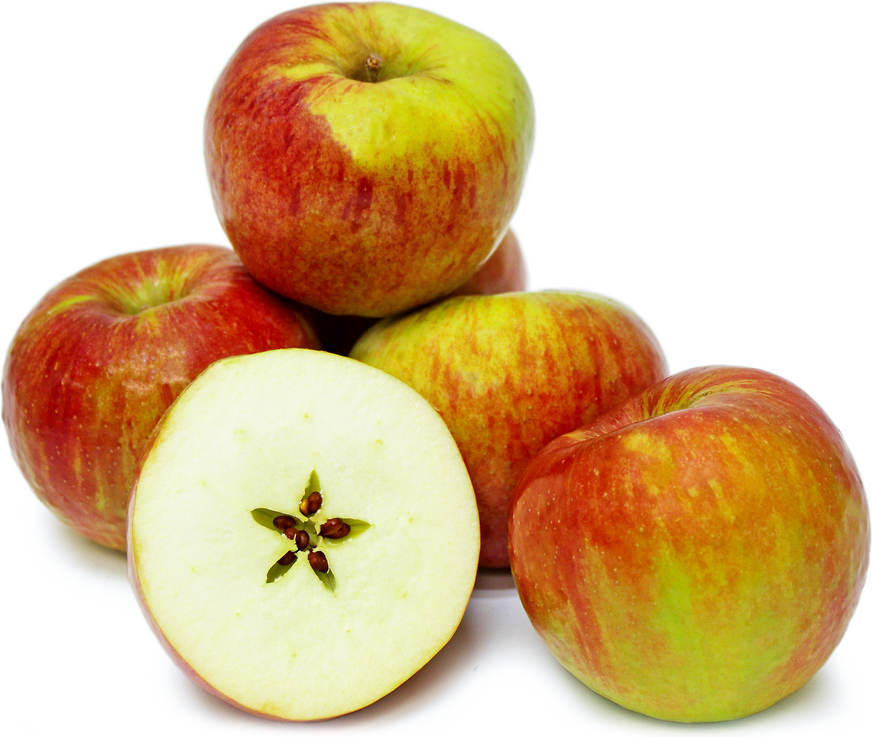


Twenty Ounce Apples
Estimated Inventory, lb : 0
Description/Taste
Twenty Ounce apples widely range in size depending on growing conditions, but the apples have the ability to become very large at maturity. The fruit’s appearance is also variable, generally being round to conical in shape, sometimes displaying large shoulders, a misshapen body, and a tapered calyx. The skin is thick, chewy, and semi-smooth with a yellow-green base, covered in red blush, striations, and striping. The surface can also be lightly ribbed and enveloped in lenticels. Underneath the skin, the pale yellow to white flesh is firm, dense, aqueous, and moderately coarse, encasing a sizeable central core filled with black-brown seeds. The flesh is crisp with a snap-like crunch when raw, but once cooked, it will soften, developing a more tender consistency. Twenty Ounce apples have a faint, honeyed aroma and a subacid, mildly sweet flavor with a subtly tangy, tart aftertaste.
Seasons/Availability
Twenty Ounce apples are available in the fall through early winter.
Current Facts
Twenty Ounce apples, botanically classified as Malus domestica, are an American heirloom variety belonging to the Rosaceae family. The cultivar was discovered as a natural mutation in an orchard in the 19th century and was named for its ability to grow to a considerable size and weight. Twenty Ounce apples are also known as 20-ounce apples, Cayuga Red Streak, Oxheart, Morgan’s Favorite, Twenty Ounce Wine, Governor Seward’s, and Coleman, and are a late-season variety favored for its cold tolerance, large fruit size, crisp, firm flesh, and mild, subtly sweet taste. Historically, the cultivar was used as a cooking apple, valued especially for baked applications such as apple pies. In the present day, Twenty Ounce apples are rare, mainly considered an old variety preserved by heirloom growers and apple enthusiasts.
Nutritional Value
Twenty Ounce apples have not been extensively studied for their nutritional value. Apple cultivars, in general, are a good source of vitamins A and C, nutrients with antioxidant-like properties to strengthen the immune system, repair cell damage, increase collagen production, and reduce inflammation. The fruits are also a source of fiber to regulate the digestive tract and contain smaller amounts of potassium to balance fluid levels within the body, calcium to protect bones and teeth, and iron.
Applications
Twenty Ounce apples have coarse, firm flesh well suited for cooked preparations. The fruits can be consumed fresh, but the flesh’s texture and mild taste are generally not preferred as a dessert apple. Twenty Ounce apples can be chopped and tossed into salads, sliced and layered onto sandwiches, or coated in nut butter and placed over toast. The apples can also be cooked into applesauce, butter, and purees, or they can be paired with sharp cheeses over artisan pizzas, flatbread, and crostini. In addition to savory preparations, Twenty Ounce apples are popularly baked into pies, tarts, cakes, muffins, and scones. They also develop a tender texture when cooked and hold their shape reasonably well, suitable for stuffing with nuts and spices, baked as a dessert. When dried, apple slices can become a chewy, mild snack with extended storage capabilities. Twenty Ounce apples pair well with spices such as cinnamon, nutmeg, and cloves, vanilla, chocolate, avocado, and meats such as pork, poultry, and beef. Whole, unwashed Twenty Ounce apples will keep 1 to 2 months when stored in a cool and dark place. It is recommended to use the fruits within one month for the best texture and flavor.
Ethnic/Cultural Info
In the United States, it is important to note that two distinct apple varieties share the name Twenty Ounce. The Twenty Ounce Pippin is an heirloom apple with a drier, blander flesh, while the Twenty Ounce variety described in this article bears a semi-aqueous, coarse texture and sweet flavor from Cayuga County, New York. Both apples are named for their large size, but Twenty Ounce Pippin is clearly distinguished by American botanists, authors, and researchers as a separate variety from Twenty Ounce. In the 1800s, northeastern American apple growers sought to change the Twenty Ounce apple’s name to Cayuga Red Streak to avoid confusion, named in honor of the apple’s home county and striped appearance, but the movement was unsuccessful. In the modern-day, the two cultivars are still challenging to distinguish and are increasingly difficult to find. The apples are mainly grown through specialty orchards, home gardens, and in abandoned grassy fields and land plots.
Geography/History
Twenty Ounce apples are believed by experts to be native to Cayuga County, New York, and were discovered sometime in the early 19th century. The parentage of the variety is unknown, but the apples were found as a chance seedling growing in the orchard of George Howland. Howland brought the apple to Massachusetts and presented the new variety to the Massachusetts Horticultural Society in 1843. The apple was also featured in “The Magazine of Horticulture” in 1844 under the name Twenty Ounce, allowing the variety to gain increased commercial recognition. Twenty Ounce apples spread across the northeastern United States, arriving in Maine in the mid-19th century. The cultivar was also introduced to the Pacific Northwest sometime between the 1860s and 1920s, as referenced in nursery records compiled by R.A. Norton in the Encyclopedia of Practical Horticulture. Today Twenty Ounce apples are an heirloom variety grown on a small scale through apple enthusiasts in the northeastern United States and the Pacific Northwest. The cultivar is also grown in limited quantities in Australia and New Zealand. When in season, Twenty Ounce apples are mainly found through specialty grocers and farmer’s markets.
Recipe Ideas
Recipes that include Twenty Ounce Apples. One
| Mary-Making |
|
Twenty Ounce Apple Pie |




